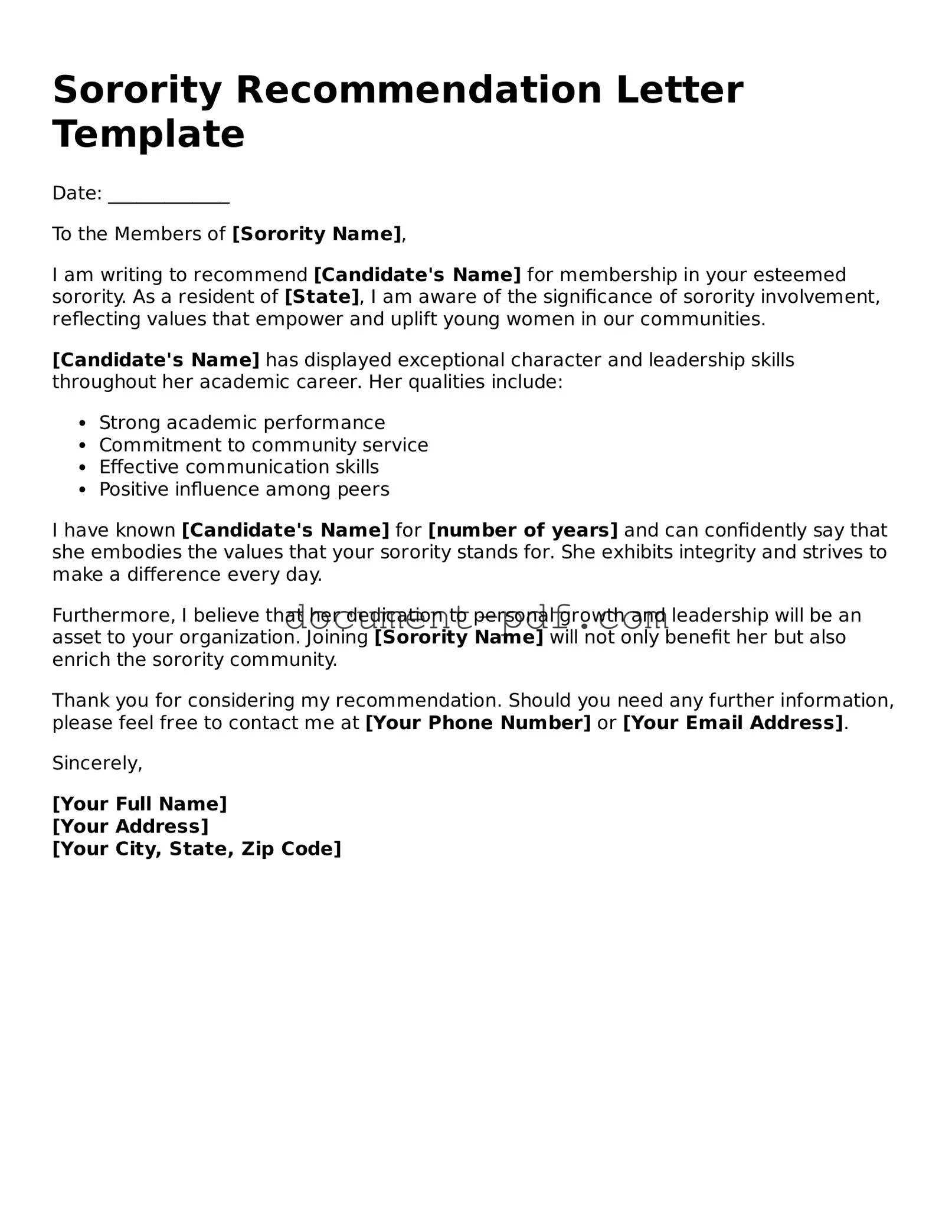The Sorority Recommendation Letter form shares similarities with the College Application Recommendation Letter. Both documents serve as endorsements, highlighting an individual's strengths and suitability for a particular group or institution. They typically include personal anecdotes and specific examples that illustrate the candidate's character and achievements. Just as a sorority recommendation emphasizes the qualities that make a potential member a good fit for sisterhood, a college recommendation letter focuses on academic and personal attributes that make a student a strong candidate for admission.
Another document akin to the Sorority Recommendation Letter is the Job Reference Letter. This letter is often provided by a former employer or colleague and outlines the applicant's skills, work ethic, and contributions to the workplace. Like sorority recommendations, job references are tailored to the specific position being applied for, ensuring that the qualities highlighted align with the expectations of the potential employer. Both documents aim to persuade the reader of the candidate's qualifications and suitability for a specific role or community.
The Graduate School Recommendation Letter is also similar in purpose and structure. This letter is written to support an applicant's admission into a graduate program, emphasizing their academic capabilities and potential for success in advanced studies. Much like a sorority recommendation, it often includes personal insights and specific examples that reflect the candidate's dedication and passion for their field. Both types of letters are crucial in helping the reviewing committee make informed decisions about prospective members or students.
The Character Reference Letter is another document that aligns closely with the Sorority Recommendation Letter. This type of letter is typically written by someone who knows the individual well, such as a mentor or community leader, and focuses on the person's character traits and moral integrity. Similar to sorority recommendations, character references provide a personal touch, offering insights into the individual’s values and how they align with the expectations of the sorority or organization in question.
The Personal Statement, while different in format, shares the goal of presenting the individual in a favorable light. This document is often required for college applications and graduate programs, allowing candidates to express their motivations, experiences, and aspirations. Like a sorority recommendation, a personal statement aims to showcase the applicant's personality and fit for the community they wish to join, making it an essential component of the application process.
For those seeking to enhance their application, a well-crafted form can be invaluable. Consider exploring this useful essential Recommendation Letter template for your needs, which is designed to streamline the process of gathering important endorsements. By utilizing this resource, you can ensure that recommenders can effectively communicate their insights.
The Letter of Intent is another document that parallels the Sorority Recommendation Letter. Often used in various applications, including for jobs and educational programs, this letter outlines the applicant's intentions and reasons for applying. It serves to convey enthusiasm and commitment, much like a sorority recommendation that expresses a desire to join a particular sisterhood. Both letters aim to persuade the reader of the applicant's genuine interest and suitability.
The Membership Application Letter, while more straightforward, shares a similar purpose with the Sorority Recommendation Letter. This document is typically submitted by individuals seeking to join a specific organization and includes their qualifications and reasons for wanting to become a member. Just as a sorority recommendation provides additional context about a candidate, a membership application letter aims to establish the applicant's motivations and fit for the group.
The Professional Networking Letter also bears resemblance to the Sorority Recommendation Letter. This type of letter is often used to introduce an individual to potential employers or contacts within a professional network. It highlights the individual's skills and experiences, much like a sorority recommendation emphasizes personal attributes and accomplishments. Both documents seek to create opportunities for the candidate by showcasing their strengths and potential contributions.
Finally, the Letter of Support for Community Service or Volunteer Work is similar in that it endorses an individual’s commitment to service and community involvement. This letter typically comes from a community leader or organization and highlights the applicant's contributions and dedication to helping others. Like a sorority recommendation, it emphasizes the values of the candidate and their alignment with the mission of the organization they wish to join, reinforcing the importance of character and community engagement.
